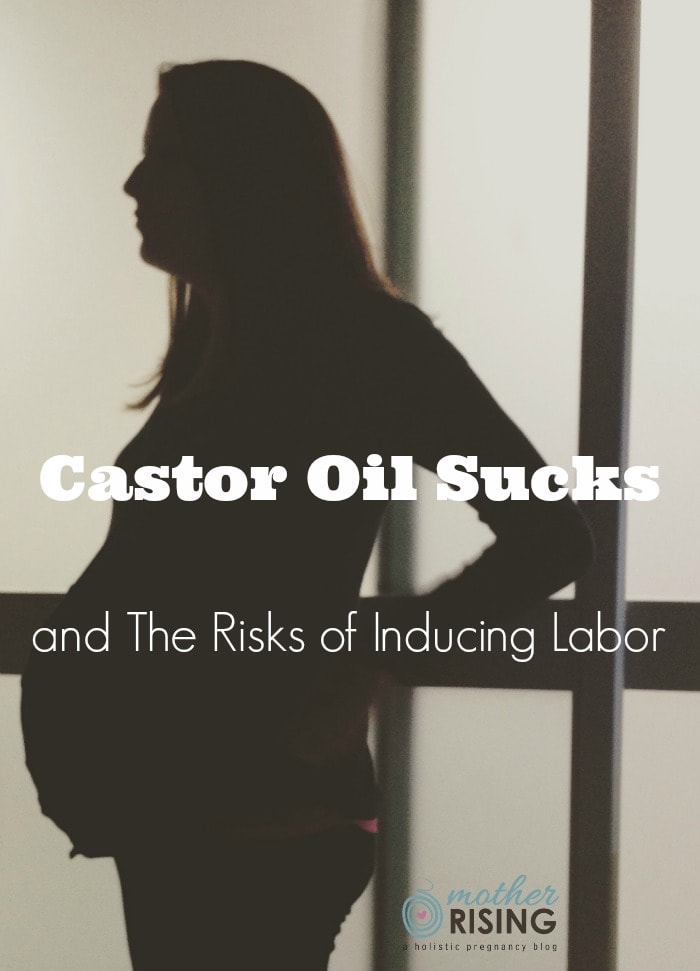This post is dedicated to the normal, healthy pregnant lady who is tired of being pregnant and wants to get the show on the road.
The Risks of Inducing Labor
Here’s the scenario… You see your care provider during your 37th – 40th week and you get the green light to have your baby (meaning if you gave birth at this stage in pregnancy your baby will likely be healthy). They may or may not discuss the risks of inducing labor.
You go home and think to yourself… “alright, then let’s HAVE this baby!”.
You turn on your computer and start googling natural methods to induce labor. You might even implement some old wives’ tales like adding pineapple and eggplant parmigiana to your diet.
You may even want to try castor oil.

Can I Stop You Right There?
I understand that you are uncomfortable, can’t sleep, puffy, suffering from heartburn, and the pressure. OH, THE PELVIC PRESSURE.
The last bit of pregnancy can really suck, big time. Believe me, I know. I have been there. THREE TIMES.
The thing is, contrary to popular belief, labor cannot be turned on like a switch. Seriously. Induction doesn’t usually work unless your body is already primed and ready to go. Don’t believe me? Check out this bishop score to learn more.
And you know what? An induction, for a first time mom, significantly increases her risk of a cesarean birth.
Now that you’ve read that, let me tell you a few risks of inducing labor.
- You will drive yourself NUTS, stress yourself and your family out. Ironically, stress, anxiety and adrenaline are not conducive to labor and birth.
- The more stressed out you are, the more likely you will be to agree to an unnecessary medical induction. Medical inductions increase the risk of fetal distress, vacuum extraction, episiotomy, drugs and epidurals, and cesarean births.
- Your baby will be born, when your baby is ready. A big problem with babies being born too early is that their lungs aren’t as mature as they need to be. If this is the case for your baby, expect extra medical help and a possibility of you and your baby being separated soon after birth. If you go into labor spontaneously, the odds of breathing difficulties at birth will be lowered.
- Sometimes women induce their labor with things like castor oil and herbs which leave them contracting, diarrhea-ing… and NOT dilating! Nobody wants to feel like crap for no reason, so ladies, put away your herbs and castor oil.
Since we like to do SOMETHING towards the end of labor, to “speed things up” the following is a list of non-labor inducing exercises you can do to make your body more favorable for birth and to get your baby better positioned (which will increase your chances of a quicker and less painful birth).
Rebozo
“Sifting, or jiggling, the entire abdomen between contractions can relax tight ligaments and help a woman relax into her labor. The hospital has muscle relaxants and narcotics to relax a woman who is either tense emotionally, or simply tense in her abdominal fascia, prolonging labor. But this simple and fun technique from the Yucatan Peninsula helps relax mothers with no drugs at all. It can be done daily or weekly in pregnancy and between contractions during early labor and early active labor.”
Inversion
“Getting into an upside down position can increase the symmetry of the lower uterine segment; release spasming ligaments causing pelvic pain; or help a breech, an oblique (diagonal lie) or posterior baby reposition themselves. Daily inversions in pregnancy may promote optimal fetal positioning. It’s important to do the inversion correctly.”
Also, check out the Daily Essentials video by Spinning Babies for detailed demonstrations of the Inversion technique and many others; it will get your baby in the optimal position for a quick, simple and less painful birth.
When to Try Castor Oil
Despite my rantings about the risks of inducing labor there is definitely a time and place for castor oil. For example, castor oil might be something to try if your water has been broken for 12+ hours but you still haven’t gone into labor.
A Final Note
I see so many mamas setting themselves up for frustration by expecting to have their baby early and never realizing that most first time moms, on average, have their babies during the 41st week.
One thing that helped me to be ok with being 40+ weeks pregnant was early on in my pregnancy I told myself that I wouldn’t have Gabriel until I was 41 almost 42 weeks pregnant. I expected to go past my due date.
If you want to be even more devious, tell your family and friends that your due date is one or two weeks later than it actually is. You will have less pressure, phone calls and well-meaning texts asking “How are you feeling?”.
Tell me, towards the end of your pregnancy(ies) how desperate were you to go into labor? Was it hard for you to wait for signs of labor? Were you aware of the risks of inducing labor? Leave me a comment and let me know.

Tina
Wednesday 7th of September 2016
I tried all the old wives tales for baby #2 including spicy food... which I hate. And I hated eating and hated how it affected my stomach. And baby was still a week late! So I decided for this baby, all I would do is just walk walk walk,. No crazy stuff! And I am indeed telling everyone baby will be a week late.
Lindsey Morrow
Monday 19th of September 2011
Lucky you! I did the primrose oil too... but not religiously. I wonder if it really helped?
Melissa
Saturday 17th of September 2011
I didn't make it to those crazy last weeks, though part of me wishes I had. My mom was post dates for all of us, and I really didn't want to be in her same position. I was determined to birth naturally and knew a medical induction greatly decreased my chances of success. I asked around 32 weeks what I could do to avoid a fight over an induction at 42 weeks. They mentioned evening primrose and i began taking at 36 + 3 (1cm/50%/+1). 10 days later at 37+6, DS, my first baby entered the world... with no other interventions :-).